#explainjokes
Explore tagged Tumblr posts
Photo

Hahaha this is old, gross and funny at the same time.
Escherichia coli (E. coli ) is one of the most common rod shaped bacteria. Most E. coli are usually harmless and they live in intestines to help breaking down food. But some strands, for example E. coli O157:H7, may infect abdominal tissues and cause diarrhea, cramping, or vomiting. E. coli can contaminate rawly processed beef if the cattle intestine parts is in or touch the beef. And E. coli is able to grow and reproduce at temperature at 10-45 C. News last month report that a brand of Canadian beef is recalled because of E. coli contamination again. https://globalnews.ca/news/4090667/lean-ground-beef-recalled-due-to-possible-e-coli/
What an intimate attachment E. coli colonies to room temperature Canadian beef ;) Joke credit to: https://forums.anandtech.com/threads/she-grew-on-him-like-she-was-a-colony-of-e-coli-and-he-was-room-temperature-canadian-beef.1969487/
39 notes
·
View notes
Photo
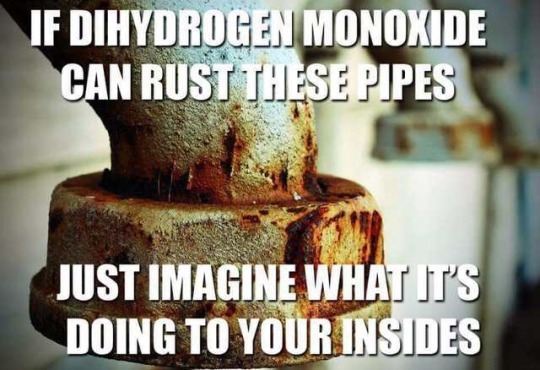
I was laughing at this page https://m.imgur.com/gallery/rXaal when I saw this pic and gazed at it, confused. Since Iron rust is Iron (III) Oxide Fe2O3, and is formed by Iron reacting to oxygen in the air, why does the picture say that water (aka H2O) rusts the pipes?
After some researches, below is the answer I find if you are confused about the same thing.
Rusting is a type of corrosion— a metal donates its electron to a nonmetal electron acceptor. Oxygen gas in the air is in its stable diatomic form O2 that doesn’t want to accept electrons. So water serves this job of electron receptor. Solid Fe dissolves into Fe2+ and 2e- in water. Water also breaks apart into H+ and OH-. OH- would take the electrons that Fe gives up according to this equation: Fe2+ + 2OH-➡️Fe(OH)2. Some oxygen dissolved in water would react with the compound too to turn Fe(OH)2 into Fe(OH)3. Then several Fe(OH)3 go through dehydration to produce Fe2O3 plus some H2O.
H2O is not consumed in the previous reactions, it just serves as a solvent for reaction to occur, which is also called a catalyst. I have learned something new today which maybe some of you guys think it’s obvious and silly, and myself as a “young dumb broke high school kid” is really thankful for your viewing of this blog :)
41 notes
·
View notes
Photo
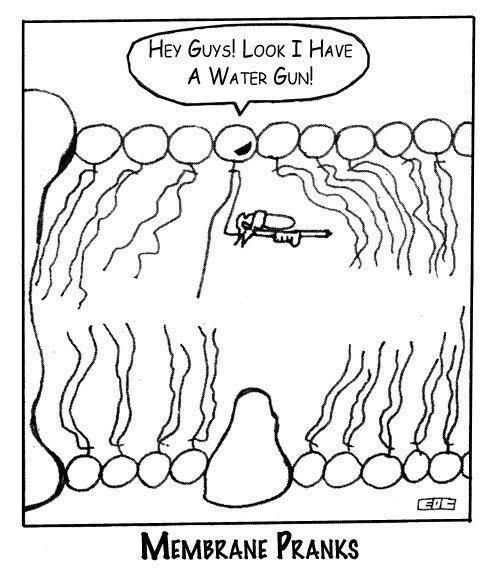
The cell membrane is a phospholipid bilayer, which means it has two layers of lipid consisting a phosphate group. Both layer contain water loving (hydrophilic) exterior or "heads" , and water hating (hydrophobic) interior or "tails". The watering loving heads are at the exterior because the outside environment usually contains water. That is why in the picture all water hating tails avoided themselves from the water gun. By the way the pear shape huge object in the picture is called intergral protein, it's embedded within the membrane and serve as transporters, carriers or receptors. This phospholipid bilayer property of the cell membrane often causes big polar (always water loving) molecules not able to pass through the water hating lipids in the membrane, so some specific proteins serve as channels or carriers. Joke (pic) credits to: https://i.pinimg.com/1200x/5a/46/00/5a4600d58802d846bf8f6fe4edc79915.jpg
39 notes
·
View notes
Photo
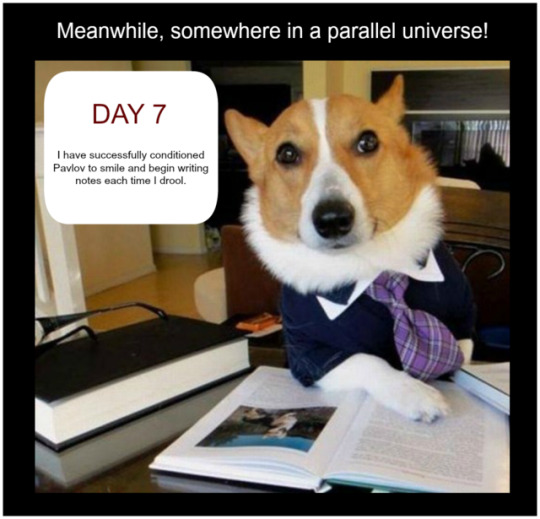
Joke explained: Pavlov is famous for an experiment of classical conditioning. The theory of classical conditioning includes a neutral stimulus (can be anything, as long as it does not provoke any sort of response in the organism) and unconditional stimulus (something that reliably results in a natural response, for example you feel nauseous when you smell rotten eggs). If neutral stimulus and unconditional stimulus always appear together, the organism will associate them and after times the neutral stimulus will also automatically and involuntarily have the effect of unconditional response on the organism. Pavlov used experiments on dogs to show his claim. He rang a bell every time before he fed the dogs. At first the bell as a neutral stimulus has no effect on the dogs. But then the dogs soon learned that bell rings are associated with food. So the dogs would involuntarily salivate and drool when they heard bell rings even if there was no food present. This jokes points out that rom the dog's point of view Pavlov could be the one affected by classical conditioning, he associated dog's drool to his experiment and automatically started taking notes. Of course this is not the truth, because unlike drooling, writing is a voluntary act, so it can not be an unconditional response. But it is just funny to think of Pavlov this way. Joke (pic) credits to: http://pin.it/Q53bq80
38 notes
·
View notes
Photo
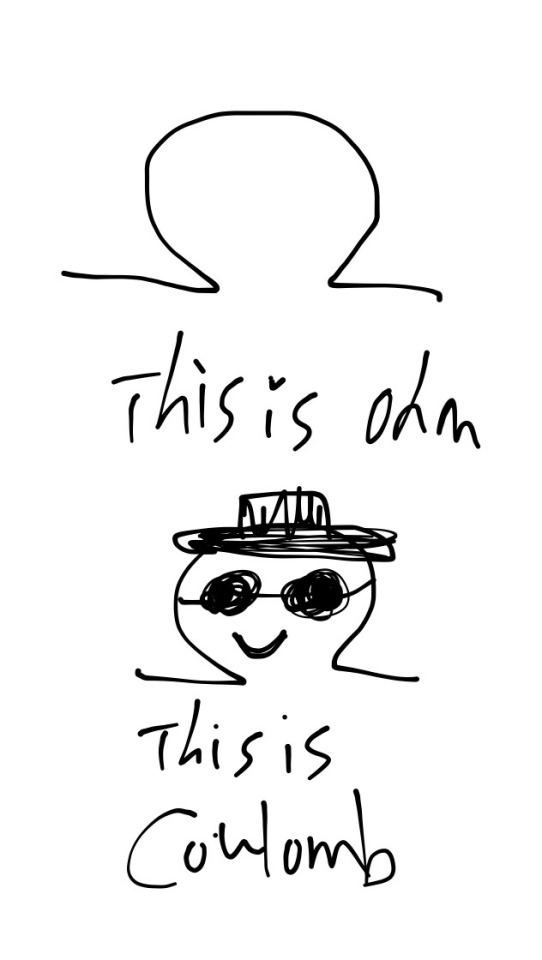
Joke Explained: Ohm (Ω) is SI unit for electric resistance. Coulomb © is SI unit for electric charge. And sunglasses is cool. Read them ohm and Coulomb out loud and I guess you will understand.
Joke Credit: Myself Pic Credit: Myself :)
44 notes
·
View notes
Photo

This one jokes comes from myself and my wonderful friends in H Genetics class :) Omg I love the class so much.
Joke Explained:
Translation is the last step to convert DNA to protein. The nucleotide of mRNA is decoded in the ribosome subunits. Every three mRNA nucleotide is called a codon. Codon AUG signals the start of translation, codons UAA/UAG/UGA mark the end of translation. Other codons code for amino acids. The long chain of amino acids created by translation, called polypeptide, will fold up and become protein.
Rnase is a type of small protein. Its function is to catalyze the degradation of RNA.
So in the joke, basically RNA created an enemy instead of a friend….actually it is a sad story :(
Joke credits to: myself and my lovely friends in my lovely Genetic class.
Oh also thx for my idol A.C who often is my motivation when life gets tough aww.
40 notes
·
View notes
Photo
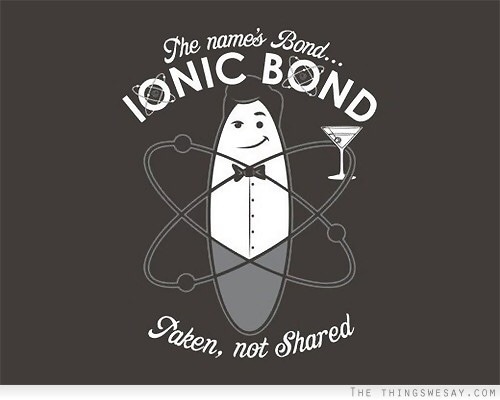
Joke explained: I guess many people know the famous quote of James Bond: Shaken, not stirred. But this time it is IONIC bond haha. An Ionic bond is formed by one atom transferring another atom electrons. In contrast, covalent bonds are formed by atoms sharing the electrons :) That is why ionic bond says: “ taken, not shared.” :) By the way I love that the two sentences “shaken, not stirred” and “taken, not shared” rhyme.
Joke (image) credits to: http://www.thethingswesay.com/the-name-s-bond-ionic-bond-taken-not-shared/
2 notes
·
View notes
Photo
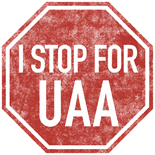
Joke explained: During the translation (creating proteins in a cell from its DNA or RNA strands) process, mRNA, aka Messenger RNA, conveys genetic codes to ribosome where translation takes place. One specific type of codon ( a series of three nucleotide bases on mRNA) signals the addition of an specific type of animo acid chain, aka polypeptide, to make up the protein. There are both three types of stop codons for RMA and for DNA. A stop codon binds signals to stop the translation process and the ribosome releases the polypeptide. UAA is one of three stop codons in RNA. Joke credits to: http://pin.it/2GfLhrL
1 note
·
View note
Text
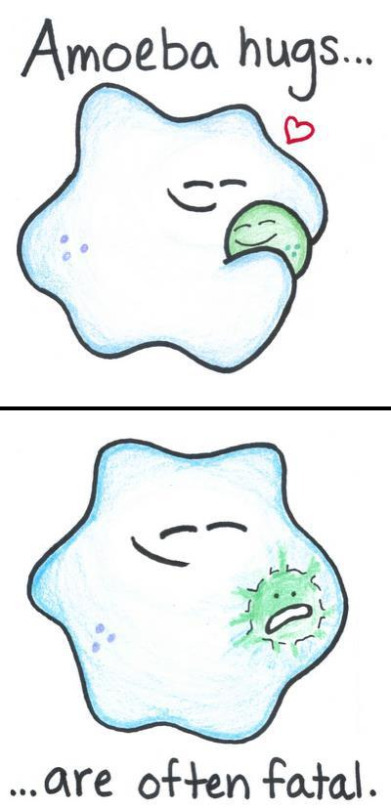
Joke explained: Amoeba is a single celled eukaryotic organism. Being eukaryotic means amoeba has a NUCLEUS and other cell contents enclosed by membranes. Because amoeba is single celled it has no mouth parts. It eats food by phagoctyosis— its membrane extends and changes shape to enclose the food. So an amoeba’s “hug” is for food instead of friends.
Joke credits to: https://nerdmonkey42.wordpress.com/2013/01/21/an-interesting-take-on-phagocytosis/amp/
1 note
·
View note
Text
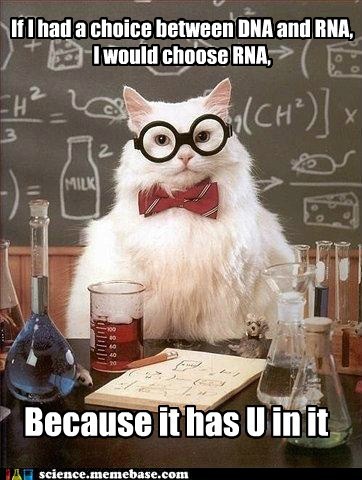
Joke explained: both DNA and RNA contain four nitrogen-containing nucleobase in its nucleotide strand(s). The unique combination of four nucleibases determines a specific DNA or RNA. The four bases in DNA strands are adenine (A), thymine (T), cytosine © , and guanine (G). A pairs with T and C pairs with G. In RNA, there is no thymine, instead, Adenine pairs with Uracil (U). Uracil only exists in RNA, not in DNA. Uracil=U=You.
Say this to your love ❤️
Joke Credit to:http://ansiogolc.tumblr.com/post/17854604701/oh-dear-god-i-find-this-far-funnier-than-i
0 notes